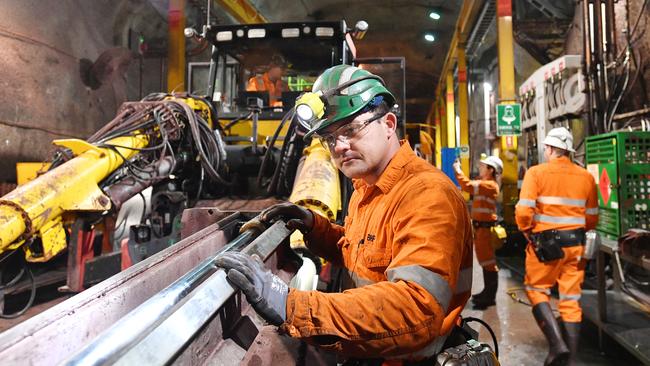BHP half year net profit lifts 29pc to $US4.87bn
BHP cautions against tax rise on the liquefied natural gas sector as it posts a 29 per cent gain in half year net profit.

BHP has cautioned the federal government against hiking taxes on the liquefied natural gas sector, warning any fiscal changes might threaten a pending investment decision on its $US11bn ($16.4bn) Scarborough gas field off Western Australia.
The Australian revealed Federal Treasury is considering lifting taxes on Australia’s LNG producers - now the largest exporters of gas in the world - as income from the 40-year-old tax is forecast to fall by $450m over the four-year budget estimates.
Major producers are understood to be considering a campaign to fight the tax move and BHP - which owns a 25 per cent stake in the Woodside-operated Scarborough field - said mooted changes to the petroleum resource rent tax (PRRT) could dim the commercial prospects for the project.
Asked if there were any issues ahead of a mid-2020 deadline to approve the project, BHP said the petroleum tax was top of the list.
“The only one I would call out is the PRRT. Clearly, if the PRRT were to change in a way that increased the tax burden on the project, that’s going to weigh on its attractiveness as an investment opportunity,” BHP chief executive Mike Henry said.
“All of these projects need to compete when it comes to our capital allocation framework, so probably enough said.”
Treasury is working on recasting the tax, which has raised more than $100bn since it started, because the industry has in large part shifted from Bass Strait oil supplies to LNG production in WA, meaning many projects pay no PRRT.
With investment decisions due this year from BHP and Woodside on Scarborough and next year from Woodside and four other partners on the long-stalled $US20.5bn Browse project, there are signs the industry might use the mega projects as a bargaining chip to fight new tax imposts.
BHP said it did not want to see “any further downside” as it weighs a commercial decision.
“None of these projects are easy. When you get into that greenfield, or near greenfield quadrant in whatever type of project, it’s difficult,” BHP’s chief financial officer Peter Beaven said.
“So we don’t want to go backwards on fiscal terms.”
Ambitious concept
Scarborough forms part of an ambitious Woodside-led Burrup Hub concept with gas from the field feeding an expansion of the existing Pluto LNG plant and the giant Browse resource feeding the North West Shelf plant via a 900-km pipeline.
Woodside has indicated it may give a green light to Scarborough with less than half the LNG sold under contract due to the coronavirus and oversupply in the market.
BHP said it was also studying contract levels for the project.
The resources giant wants to “be able to cap the downside or reduce downside risk in the project, given the range of potential market outcomes and part of that is our commercial contracting strategy”.
“I wouldn’t want to give a specific number, other than to say it’s something we’re quite focused on,” Mr Henry told analysts.
Iron ore price boost
Earlier BHP’s half-year profits surged on the back of the strong iron ore price, but its US65c a share interim dividend fell short of analyst expectations.
Analyst consensus tipped BHP to deliver a US71c a share dividend for the first half of the year, returning the windfall iron ore profits – driven by Vale’s Brazilian tailings dam disasters a year ago.
BHP’s net profit rose 29 per cent to $US4.87bn compared to the first half of the previous financial year, with operating profit up 13 per cent to $US8.3bn and underlying earnings before interest, tax, depreciation and amortisation up 15 per cent to $US12.1bn.
New BHP CEO Mike Henry said the company had delivered solid cash flow.
“Despite near term uncertainty – due to the coronavirus outbreak, trade policy and geopolitics – we remain convinced about the positive underlying fundamentals of our commodities,” Mr Henry said.
Higher prices as well as the falling Australian dollar boosted BHP’s flagship iron ore division, with its Pilbara miners delivering earnings before interest and tax of $US6.3bn for the half-year, on revenue of $US10.4bn.
BHP said it expects iron ore prices to remain volatile as Vale’s Brazilian mines slowly return to full capacity over the next two years, amid a “moderate” increase in Chinese steel production.
BHP shares traded higher through the day on Tuesday.




To join the conversation, please log in. Don't have an account? Register
Join the conversation, you are commenting as Logout